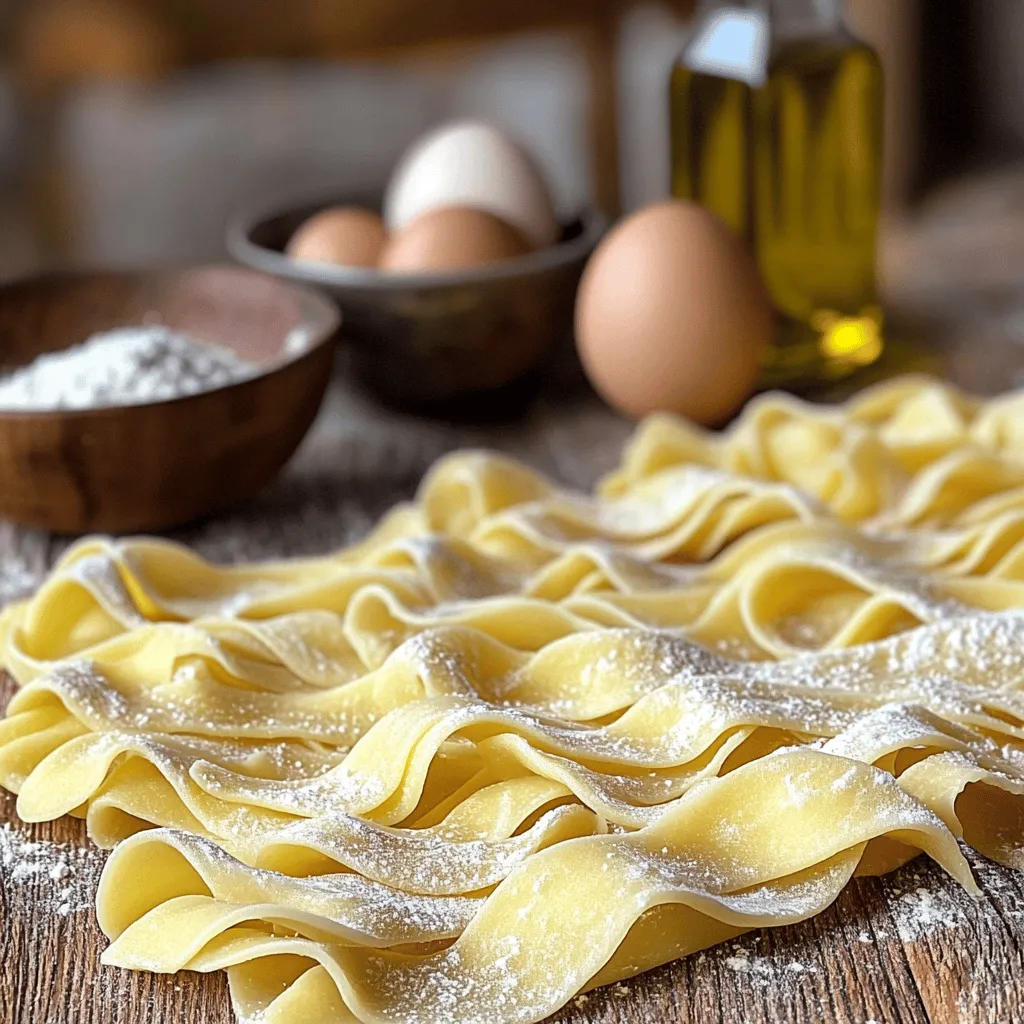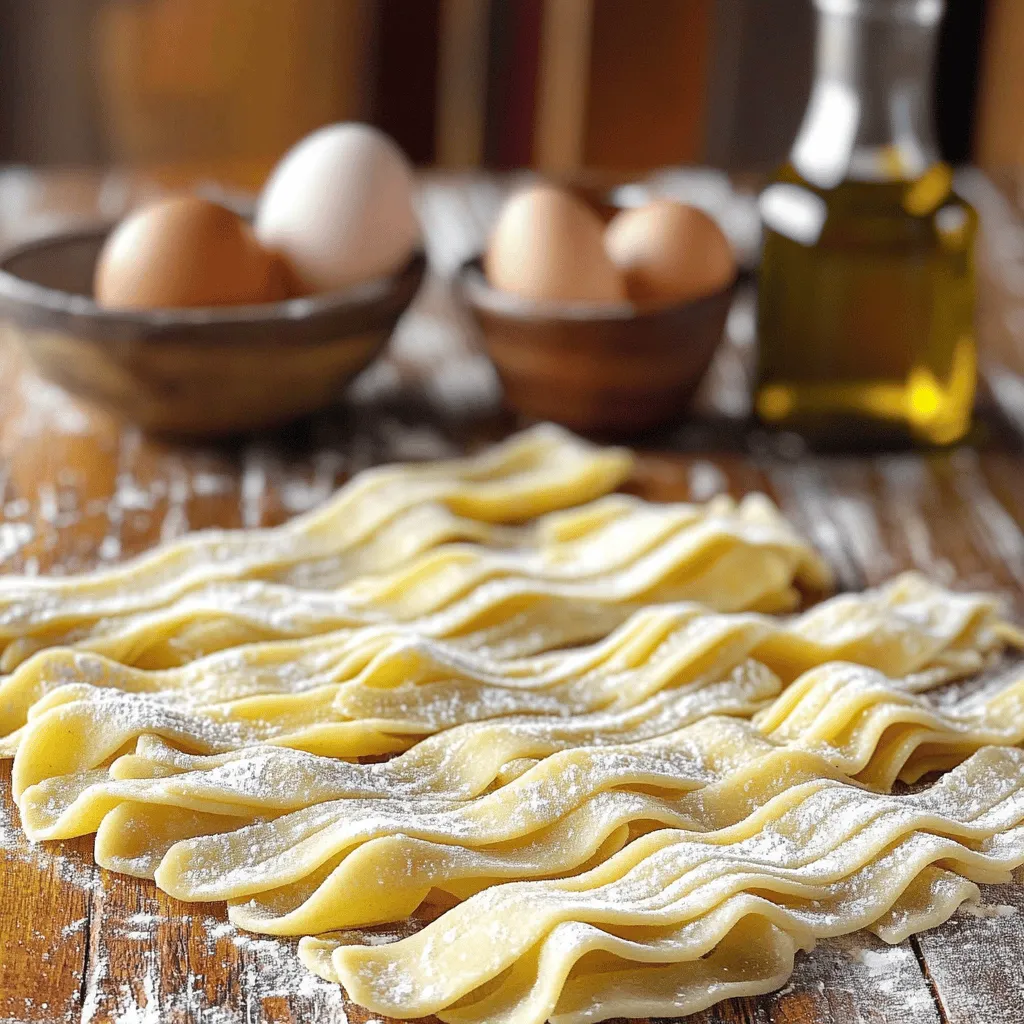Making homemade egg noodles is simpler than you think! With just a few basic ingredients—eggs, flour, salt, and olive oil—you can create a dish that delights every palate. In this guide, I’ll walk you through the step-by-step process, share tips for the perfect texture, and explore delicious ways to serve your noodles. Get ready to impress your family and friends with fresh pasta made right in your kitchen!
What Are the Basic Ingredients Needed for Homemade Egg Noodles?
To make homemade egg noodles, you need just a few simple ingredients. The main ingredients for egg noodles are eggs, flour, salt, and olive oil. You can easily find these at any grocery store.
What Type of Flour is Best for Making Egg Noodles?
I always use all-purpose flour for making egg noodles. This type of flour works well because it has the right amount of protein. It helps the noodles hold their shape and gives them a nice bite. If you want a different taste, you can also try using semolina flour. It adds a slightly grainy texture, which some people love.
Why Choose Fresh Eggs for Homemade Pasta?
Fresh eggs make a big difference in flavor and texture. The yolks are rich and bright, giving the noodles a lovely color. Plus, fresh eggs have a firmer white, which helps the noodles stay together. When you crack open a fresh egg, you will notice the difference right away.
Can I Substitute Ingredients in the Egg Noodle Recipe?
Yes, you can substitute some ingredients in the egg noodle recipe. If you’re out of olive oil, you can use vegetable oil instead. You can also substitute regular flour with whole wheat flour for a healthier option. Just remember that it might change the texture a bit. If you need to, add a little more water to help the dough come together.
In my experience, using the right ingredients helps create a perfect batch of egg noodles. This way, you can enjoy a tasty meal that feels special and homemade.
How Do You Make Homemade Egg Noodles Step-by-Step?
Making homemade egg noodles is fun and simple. With just a few steps, you can create your own fresh pasta.
What Are the Key Steps to Kneading the Dough?
Start by mixing flour and salt in a bowl. Make a well in the center. Crack your eggs into this well. Add olive oil. Use a fork to beat the eggs gently. Slowly mix in the flour from the sides. Once the dough starts to form, knead it with your hands. If it’s too dry, add water a little at a time. Knead until the dough is smooth and elastic. Wrap it in plastic wrap and let it rest for at least 30 minutes. This resting time helps the gluten relax.
How Thin Should the Dough Be Rolled Out?
When you roll out your dough, aim for a thickness of about 1/16 inch. This will give you tender noodles. Use a rolling pin or pasta machine to get it thin. Dust the surface with extra flour to keep it from sticking. If you roll it too thick, the noodles will be chewy instead of soft.
What Shapes Can You Cut Your Noodles Into?
You can cut your noodles into many shapes. Try fettuccine, tagliatelle, or even pappardelle. Use a sharp knife or a pasta cutter for clean edges. After cutting, dust the noodles with flour to keep them separate. This will help prevent clumping when you cook them.Enjoy your homemade egg noodles!

How Can You Ensure the Perfect Texture for Your Egg Noodles?
To get the best texture for your egg noodles, focus on a few key steps. First, the right cooking method matters. You can boil, sauté, or even bake them. Boiling is the most common way.
What Cooking Techniques Help Achieve the Right Texture?
Start by boiling water with a good amount of salt. This adds flavor. Once boiling, add your noodles. Stir gently to prevent sticking. Boil until they float. This usually takes about 2-4 minutes. Fresh noodles cook faster than dried ones.
How Long Should You Cook Homemade Egg Noodles?
Cooking time depends on the thickness of your noodles. For thin noodles, 2-3 minutes is enough. Thicker noodles may need up to 4 minutes. Always taste a noodle before draining. You want them al dente, which means firm but not hard.
What Tips Can Improve the Chewiness of Noodles?
To make your noodles chewier, knead the dough well. Kneading helps develop gluten. This gives the noodles structure. Also, let your dough rest. Resting for 30 minutes allows the gluten to relax. This leads to a better texture.
What Are the Different Types and Variations of Egg Noodles?
Egg noodles come in many styles. Each type holds a unique place in various dishes. You can find them in Asian cuisine, Italian meals, and more. The versatility makes egg noodles a favorite for many cooks.
What Are Some Popular Styles of Egg Noodles?
Some popular styles include fettuccine, tagliatelle, and chow mein. Fettuccine works great in creamy sauces. Tagliatelle shines with rich, meaty toppings. Chow mein is a stir-fried noodle often found in Chinese dishes. Each style offers a different taste and texture, making them fun to use.
How Do Different Cultures Use Egg Noodles in Their Cuisine?
Different cultures use egg noodles in many ways. In Italy, you might see them in lasagna or pasta dishes. In Asia, they often appear in soups or stir-fries. Jewish cuisine features egg noodles in kugel or chicken soup. Each culture adds its own twist, making egg noodles a global delight.
What Are the Differences Between Thick and Thin Egg Noodles?
Thick noodles are hearty and chewy. They pair well with strong sauces. Thin noodles are light and delicate. They work best with light dressings or broth-based dishes. Choosing the right thickness can change the whole meal experience. No matter the thickness, homemade egg noodles are fun to create.

How Can You Store and Preserve Homemade Egg Noodles?
Storing homemade egg noodles properly helps keep them fresh. Here are some tips to help you.
What Are the Best Methods for Drying Egg Noodles?
To dry egg noodles, lay them flat on a clean surface. Use a drying rack or hang them on a clean clothesline. Make sure there is space between each noodle. Drying can take a few hours. Check for firmness. Once dry, they can last a few weeks.
How Should You Store Freshly Made Noodles?
If you make fresh noodles, you can store them in the fridge. Place them in an airtight container. Use parchment paper between layers to prevent sticking. They stay fresh for about two days. For longer storage, you can dry them as mentioned.
Can You Freeze Homemade Egg Noodles for Later Use?
Yes, you can freeze homemade egg noodles. First, let them cool if cooked. Then, place them in freezer bags. Remove as much air as possible. They can stay frozen for up to three months. When ready to use, cook them straight from the freezer.
Whether drying, refrigerating, or freezing, these tips help you enjoy your homemade egg noodles later!
What Are Some Delicious Ways to Serve Homemade Egg Noodles?
Egg noodles are so versatile. You can serve them in many tasty ways.
What Sauces Pair Best with Homemade Egg Noodles?
You can use many sauces with homemade egg noodles. A classic choice is a simple butter sauce. Just melt butter, add garlic, and toss in the noodles. For a richer flavor, try a creamy Alfredo sauce. Mix heavy cream, butter, and cheese for a dreamy dish. You could also go for a tomato sauce. It adds a fresh taste to the noodles. A pesto sauce gives a nice herby flavor. You can easily make it with basil, garlic, and olive oil.
How Can You Incorporate Egg Noodles into Comfort Foods?
Egg noodles fit perfectly into comfort foods. You can make a warm chicken noodle soup. Simply boil chicken with carrots and celery. Add your fresh noodles at the end for a cozy meal. Another option is beef stroganoff. Cook beef with mushrooms and onions. Stir in sour cream and serve it over egg noodles. This dish warms the heart and fills the belly. You can also bake noodles with cheese and veggies for a hearty casserole.
What Are Some Easy Recipes Using Egg Noodles for Special Occasions?
For special occasions, egg noodles can shine. Make a festive noodle salad with colorful veggies. Toss them with a light vinaigrette for a fresh touch. You can also create a yummy noodle bake for family gatherings. Layer noodles with meat, cheese, and sauce in a baking dish. Bake until bubbly and golden. For holidays, serve noodles with a rich gravy over them. This adds warmth to any holiday meal.
Using egg noodles opens up a world of flavors and fun.
Homemade egg noodles are simple and rewarding. We covered key ingredients like fresh eggs and flour. I explained how to make the noodles step-by-step. You learned the best techniques for texture and cooking time. We also explored variations and ways to store them. Finally, I shared tasty serving suggestions.
Remember, making your own noodles can bring joy to your meals. Enjoy crafting delicious dishes with this easy recipe!



